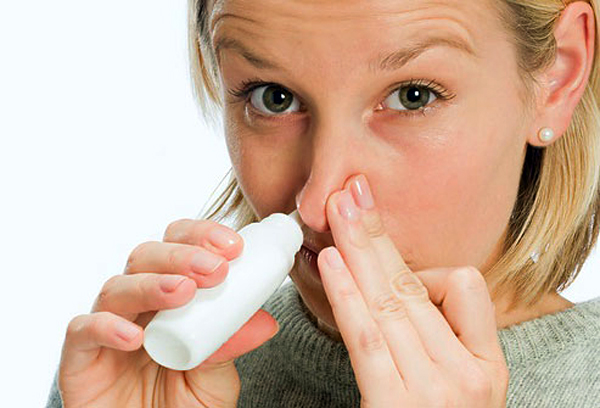
The name – nasal spray – makes its utility and function very clear. It is a spray that is used in the nasal cavity. The spray is a fine mist (or aerosol) of active ingredients that are delivered to the body, through the nostrils. The active ingredients travel down through the respiratory tract and are quickly absorbed into the bloodstream. Thus, the medicine is delivered quickly to any part of the body since the circulatory system connects all the parts. The canister holding the spray is designed with an intelligent nozzle such that it delivers only a prescribed amount of the medication per spray. This is how the dosage is regulated in nasal sprays.
Types
Nasal sprays come in two different forms. These are either pump bottles or pressurized canisters. They are of varying types.
1. The antihistamine nasal sprays are used against allergies in people. Histamines are the indicator molecules in the body that cause allergies. The sprays counter them.
2. The decongestant nasal sprays constrict the blood vessels that are lining the nose and help to open up the nasal passage.
3. There are also corticosteroid nasal sprays that help in relieving rhinitis, sinusitis and hay fever. They can also help combat allergies.
4. Then, there are natural nasal sprays which are devices that release a mist of saline solution. These help in relieving dryness and irritation in the nasal canals. They also aid in the removal of airborne dust and other irritants like pollen. The latest use for a nasal spray has been to confer immunization from flu.
Uses
The nasal spray has been found to be very effective against congestion in the nose and rhinitis which can affect a person considerably. The concept of the nasal spray was originally evolved to combat diseases that affect the nose. But now, it is being used in the treatment of many systemic diseases as well. Central precocious puberty (in which children face onset of puberty at very tender ages), osteoporosis (in which the bones become hollow and porous) and diabetes insipidus (the minor form of diabetes where the kidneys are unable to retain water) are some of the systemic diseases that are regularly treated with nasal sprays. Nicotine replacement therapy which helps the smokers quit smoking is also being done through nasal sprays. Research is being directed towards using nasal sprays in the treatment of diabetes mellitus, epilepsy and pains.
The nasal spray hydrates the nasal passages and soothes the inflamed membranes. Thus, in cases of acute cold or severe allergy, the spray is an instant rescue act. It is very good for alleviating the symptoms of a flu. Some sprays can be used for children also though this should be done only after consulting with the physician.
There are many advantages of using the nasal spray over other modes of medication. For one, the sprays work quickly and bring almost an immediate relief. This is because the onset of their action takes place almost instantly. They also have lesser side effects compared to medicines that are taken orally. Thus, a nasal spray would, any day, work better than a pill, tablet or syrup. The sprays are also easier to store and easier to administer compared to a pill or tablet. That is why, at times the physician prescribes two or more sprays to be used in tandem.
Side effects
Any form of medicine has its pros and cons like the two sides of the same coin. Nasal sprays carry their own disadvantages in the form of side effects. One of the commonest and foremost side effects is the bad taste in the mouth (no pun intended) that it leaves behind. This happens due to the active ingredients in the spray that are bitter in taste. A person regularly using nasal sprays may also suffer headaches. Epistaxis, which is defined as the acute hemorrhage form of the nasal cavity, nostril or nasopharynx also occurs. This implies heavy bleeding from the nose.
Nasal sprays can also cause coughing symptoms and later lead to infections of the upper respiratory tract too! It is really paradoxical that a medicinal respiratory device itself causes respiratory problems. Rhinitis medicamentosa is also called rebound rhinitis because it is a congestion caused by using sprays that were supposed to clear the congestion in the first place. There may also be a destruction of cells involved in smelling. This leads to problems in using the sense of smelling. This leads to secondary problems in tasting. Did you know that the sense of smell is vital for tasting. If you pinch your nose while eating in apple, the taste will change and it may get mistaken for a boiled potato! That is how the taste depends on the sense of smell and the spray affects both these.
One of the greatest problems with a nasal spray is the dependency that it builds in. Just like drugs, the spray makes the user ‘need’ it with growing intensity. The user becomes dependent on it and no other substitute is ever possible. This is an addiction.
Administration procedure
There is a set method by which one should administer the nasal spray. First of all, one must blow and clear one’s nose. The nostril and nasal canal must be free of any mucus and dirt. Then, shake the canister or pump thoroughly before use. If you are administering through the pump bottles, spray a couple of times in the air to ensure that the spray is being dispersed properly as a mist. Then alone can it be used as a nasal spray.
Now, hold the nozzle of the spray close to your nostril. Use you fingers to close the other nostril ( which is not being used for the spray). Depress the container to release a spray. Take a gentle but deep breath. Repeat this whole procedure for the other nostril as well.




